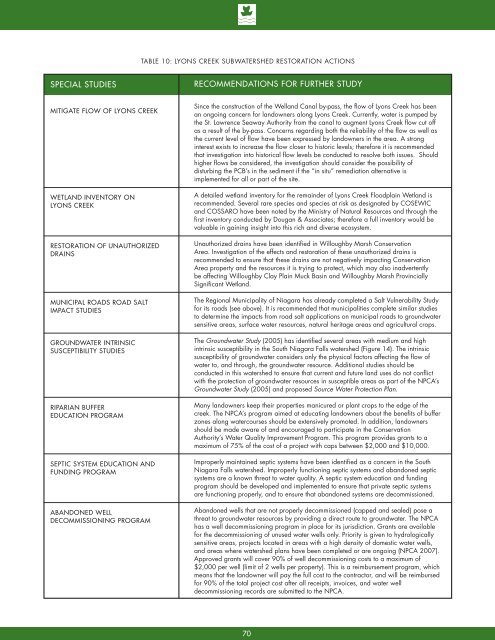8132 - NPCA SNF Watershed Report.indd - Niagara Peninsula ...
8132 - NPCA SNF Watershed Report.indd - Niagara Peninsula ...
8132 - NPCA SNF Watershed Report.indd - Niagara Peninsula ...
You also want an ePaper? Increase the reach of your titles
YUMPU automatically turns print PDFs into web optimized ePapers that Google loves.
Table 10: Lyons Creek Subwatershed Restoration ActionsSPECIAL STUDIESRECOMMENDATIONS FOR FURTHER STUDYMITIGATE FLOW OF LYONS CREEKWETLAND INVENTORY ONLYONS CREEKRESTORATION OF UNAUTHORIZEDDRAINSMUNICIPAL ROADS ROAD SALTIMPACT STUDIESGROUNDWATER INTRINSICSUSCEPTIBILITY STUDIESRIPARIAN BUFFEREDUCATION PROGRAMSEPTIC SYSTEM EDUCATION ANDFUNDING PROGRAMABANDONED WELLDECOMMISSIONING PROGRAMSince the construction of the Welland Canal by-pass, the flow of Lyons Creek has beenan ongoing concern for landowners along Lyons Creek. Currently, water is pumped bythe St. Lawrence Seaway Authority from the canal to augment Lyons Creek flow cut offas a result of the by-pass. Concerns regarding both the reliability of the flow as well asthe current level of flow have been expressed by landowners in the area. A stronginterest exists to increase the flow closer to historic levels; therefore it is recommendedthat investigation into historical flow levels be conducted to resolve both issues. Shouldhigher flows be considered, the investigation should consider the possibility ofdisturbing the PCB’s in the sediment if the “in situ” remediation alternative isimplemented for all or part of the site.A detailed wetland inventory for the remainder of Lyons Creek Floodplain Wetland isrecommended. Several rare species and species at risk as designated by COSEWICand COSSARO have been noted by the Ministry of Natural Resources and through thefirst inventory conducted by Dougan & Associates; therefore a full inventory would bevaluable in gaining insight into this rich and diverse ecosystem.Unauthorized drains have been identified in Willoughby Marsh ConservationArea. Investigation of the effects and restoration of these unauthorized drains isrecommended to ensure that these drains are not negatively impacting ConservationArea property and the resources it is trying to protect, which may also inadvertentlybe affecting Willoughby Clay Plain Muck Basin and Willoughby Marsh ProvinciallySignificant Wetland.The Regional Municipality of <strong>Niagara</strong> has already completed a Salt Vulnerability Studyfor its roads (see above). It is recommended that municipalities complete similar studiesto determine the impacts from road salt applications on municipal roads to groundwatersensitive areas, surface water resources, natural heritage areas and agricultural crops.The Groundwater Study (2005) has identified several areas with medium and highintrinsic susceptibility in the South <strong>Niagara</strong> Falls watershed (Figure 14). The intrinsicsusceptibility of groundwater considers only the physical factors affecting the flow ofwater to, and through, the groundwater resource. Additional studies should beconducted in this watershed to ensure that current and future land uses do not conflictwith the protection of groundwater resources in susceptible areas as part of the <strong>NPCA</strong>’sGroundwater Study (2005) and proposed Source Water Protection Plan.Many landowners keep their properties manicured or plant crops to the edge of thecreek. The <strong>NPCA</strong>’s program aimed at educating landowners about the benefits of bufferzones along watercourses should be extensively promoted. In addition, landownersshould be made aware of and encouraged to participate in the ConservationAuthority’s Water Quality Improvement Program. This program provides grants to amaximum of 75% of the cost of a project with caps between $2,000 and $10,000.Improperly maintained septic systems have been identified as a concern in the South<strong>Niagara</strong> Falls watershed. Improperly functioning septic systems and abandoned septicsystems are a known threat to water quality. A septic system education and fundingprogram should be developed and implemented to ensure that private septic systemsare functioning properly, and to ensure that abandoned systems are decommissioned.Abandoned wells that are not properly decommissioned (capped and sealed) pose athreat to groundwater resources by providing a direct route to groundwater. The <strong>NPCA</strong>has a well decommissioning program in place for its jurisdiction. Grants are availablefor the decommissioning of unused water wells only. Priority is given to hydrologicallysensitive areas, projects located in areas with a high density of domestic water wells,and areas where watershed plans have been completed or are ongoing (<strong>NPCA</strong> 2007).Approved grants will cover 90% of well decommissioning costs to a maximum of$2,000 per well (limit of 2 wells per property). This is a reimbursement program, whichmeans that the landowner will pay the full cost to the contractor, and will be reimbursedfor 90% of the total project cost after all receipts, invoices, and water welldecommissioning records are submitted to the <strong>NPCA</strong>.70
















